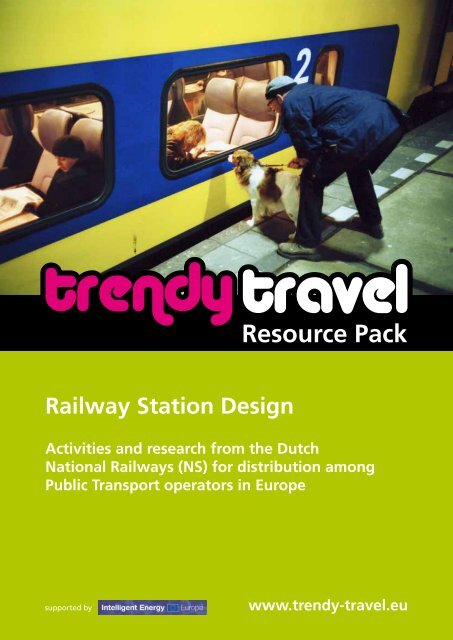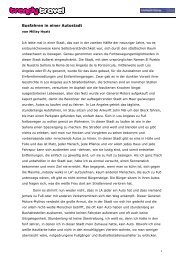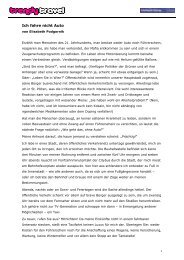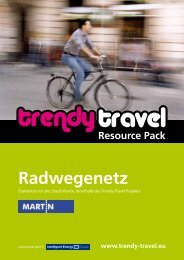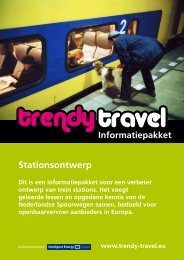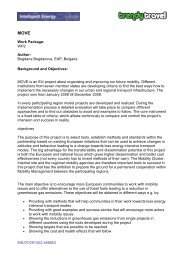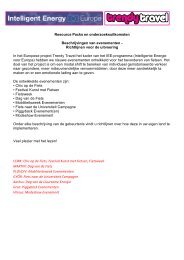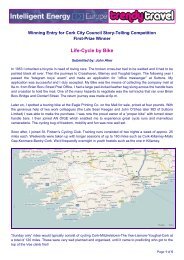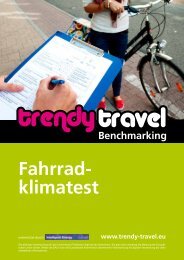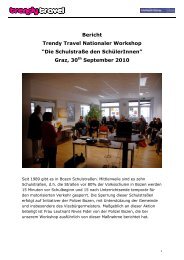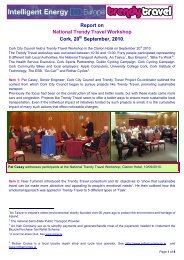Resource Pack: Railway Station Design - Eltis
Resource Pack: Railway Station Design - Eltis
Resource Pack: Railway Station Design - Eltis
Create successful ePaper yourself
Turn your PDF publications into a flip-book with our unique Google optimized e-Paper software.
<strong>Resource</strong> <strong>Pack</strong><br />
<strong>Railway</strong> <strong>Station</strong> <strong>Design</strong><br />
Activities and research from the Dutch<br />
National <strong>Railway</strong>s (NS) for distribution among<br />
Public Transport operators in Europe<br />
supported by<br />
www.trendy-travel.eu
Intelligent Energy – Europe (IEE)<br />
TRENDY TRAVEL - Emotions for Sustainable Transport<br />
<strong>Resource</strong> <strong>Pack</strong>:<br />
<strong>Railway</strong> <strong>Station</strong> <strong>Design</strong><br />
Author: NS / DTV Consultants, Mark van Hagen & Renske Martijnse<br />
Contact: email: mark.vanhagen@ns.nl phone: +31 30 235 7781<br />
Date: March 2010<br />
Version no. 1.0<br />
WP3 deliverable 3.12
Content<br />
1. Introduction……………………………………………………………………………………………..2<br />
2. Customer-wish-pyramid………………………………………………………………………...….3<br />
3. The three main dimensions of experiences…………………………………………………..5<br />
4. The fast area and the slow area ………………………………………………………………...8<br />
5. ‘Middle of the road’ or segmented approach?....................................................10<br />
6. The influence of colour and light on the experience and satisfaction<br />
with a Dutch railway station……………………………………………………………………...11<br />
7. Recommendations regarding other atmospheric elements at train stations..…..15<br />
7.1 Music………………………………….15<br />
7.2 Scent………………………………….15<br />
7.3 Spatial and functional design…15<br />
7.4 Visuals and Art…………………….16<br />
7.5 Green………………………………….16<br />
7.6 TV-screens…………………………..16<br />
8. Waiting becomes fun: the influence of advertising and infotainment on the waiting<br />
experience …………………………………………………………………………………………………..17<br />
9. Used literature…………………………………………………………………………………………..22<br />
1<br />
EIE/07/291/SI2.466803
1. Introduction<br />
This is a resource pack for improved (train) station design, compiling lessons learned<br />
and knowledge gained from activities and research from the Dutch National <strong>Railway</strong>s<br />
(NS) for distribution among Public Transport operators in Europe. The NS wants to<br />
share the benefit of its research and experiments with other rail networks.<br />
Customer satisfaction is very important for service organizations since it is a<br />
determinant for loyalty and consequently for a healthy financial situation. Customer<br />
satisfaction largely depends on the evaluation of the product or service. In the <strong>Railway</strong><br />
sector, the company’s efforts are often focused on accelerating the speed or reliability<br />
of the train journey. Less attention has been paid to passengers waiting at the station<br />
and how they experience this wait, i.e. the subjective waiting and travelling time.<br />
Based on extensive research on the valuation of train passengers’ door-to-door<br />
journeys we conclude that as the main customer of the station area he benefits most<br />
from an area which gives a fast interchange, offers many different facilities and<br />
provides a pleasant environment to be in.These wishes can be translated into three<br />
strategies for redevelopment: acceleration, concentration and enhancement. These<br />
strategies can in turn be translated into practical steps by making a clear distinction<br />
between the fast and slow sub-areas of a station area. The fast area comprises the<br />
transfer space and transfer related services. The slow area offers commercial activities<br />
not directly related to the transfer and long-stay urban functions, such housing,<br />
offices and leisure facilities.<br />
In order to find out how much time passengers spend at a station and how they<br />
experience the time and the wait, a field study was conducted whereby observations<br />
of behaviour were combined with structured (self-reported) questionnaires. The<br />
results show that passengers spend on average 7 minutes at a station, the majority of<br />
which is on the platform. Passengers generally appear to overestimate the length of<br />
the wait at the station. The shorter the wait, the greater the overestimation of the<br />
waiting time. Passengers particularly overestimate the waiting time when they have<br />
nothing to do and when they are delayed.<br />
It also appeared that passengers attach importance to a pleasant waiting<br />
environment. It is advisable to limit the waiting time to a minimum and to organize<br />
and design the service environment in such a way that irritation and stress be<br />
prevented as much as possible. This can be realized by a specific deployment of<br />
atmospheric elements. Pleasant surroundings are conducive to passengers’ forgetting<br />
the time and being more positive in their evaluation of the wait. Improving the waiting<br />
environment on the platform can be achieved by stimulating the senses in such a way<br />
that passengers experience a maximum level of comfort.<br />
Depending on the circumstances, waiting for a service can evoke a wide range of<br />
negative reactions, such as boredom, irritation, anxiety and stress. These negative<br />
emotions influence the customer satisfaction and the evaluation of the service quality.<br />
2<br />
EIE/07/291/SI2.466803
The longer one thinks (s)he has had to wait, the more dissatisfied one is about the<br />
service.<br />
Besides minimizing the objective waiting time, the NS considers it therefore also<br />
essential to invest in a qualitative impulse to train stations, to positively influence the<br />
perceived (subjective) waiting time. The purposeful deployment of specific<br />
environmental elements (such as colours and lighting or advertising and infotainment)<br />
can work as a distractor and as such influence the emotions and the subjective<br />
estimation of time. The NS hopes to increase the satisfaction of its existing customers<br />
and to attract new customers. Since the train is a sustainable mode of transport,<br />
expanding its customer base is not only in the interest of the railway organizations but<br />
also of the local and national governments of a country.<br />
This ‘incentive’ resource pack starts with an analysis of customer wishes, based on the<br />
customer-wish-pyramid. Furthermore, the value of experiences is explained, the three<br />
main dimensions of experiences: pleasure, profit (usefulness) and meaning (being<br />
memorable) are elaborated and the differences between the fast area and the slow<br />
area are identified.<br />
In the second part, the choice between a ‘middle of the road’ or a segmented<br />
approach is discussed and recommendations regarding atmospheric elements at train<br />
stations are given. Results from two virtual experiments with colour and light are<br />
explained and other elements such as music, art, scent and plants will be touched<br />
upon as well.<br />
To change the modal split towards more sustainable travel behaviour, more people<br />
need to be attracted to public transport. Existing and potential travellers need to feel<br />
their journey is as pleasant as possible. This resource pack identifies tools that<br />
contribute to that.<br />
3<br />
EIE/07/291/SI2.466803
2. Customer-wish-pyramid<br />
Research shows that travelers base their choice for the car or for public transport not<br />
only on price, but mainly on differences in safety, reliability, travel time, comfort,<br />
convenience and experience. These aspects of quality can be put in a schematic<br />
pyramid (see below). For a satisfied customer, all aspects are important, but not all<br />
are equally important. The pyramid shows that the quality aspects on the lowest<br />
levels are considered most important by travelers. Based on previous research,<br />
quantitative values can be attached to the customer-wish-pyramid. A striking result is<br />
that all quality dimensions are of importance, without a real peak. The dimensions<br />
(social) safety and reliability (cleanliness and punctuality) determine half of the values<br />
(50%). The satisfiers count for over 20% when calculating the satisfaction of travelers<br />
about a train trip (experience 9%, comfort 12%). The dissatisfiers “ease” and “speed”<br />
each count for around 15%.<br />
Customer-wish-pyramid: transfer / move<br />
Source: Van Hagen, August 2003<br />
The importance that a traveler gives to these customer wishes depends on how often<br />
a person travels, and with which goal or travel motive. A clear distinction can be made<br />
between ‘must’- and ‘lust’-motives. Must-travelers can mainly be found during<br />
4<br />
EIE/07/291/SI2.466803
morning rush hour. Must-motives have a mandatory character and the location,<br />
starting time, travel time and regularity are often fixed. Must-travelers attach much<br />
value to speed and reliability of their familiar journey.<br />
Lust-motives take place in a traveler’s spare time and the location, starting time and<br />
regularity for these activities vary. Lust travelers relatively attach more value to<br />
comfort and experience. The relatively unknown trip is often an experience in itself,<br />
and the time pressure – which is a notable characteristic of must motives – is mostly<br />
absent. Must- as well as lust-travelers appreciate convenience when they travel,<br />
especially in the form of clear and up-to-date travel information.<br />
The above has indicated which quality dimensions are important and to what levels,<br />
for people who are on the move or who are transferring. But people also stay<br />
somewhere for a (longer or shorter) period during their trip, for example in a wagon<br />
or at a station. During this period of sojourning, different customer wishes prevail.<br />
Train stations have somewhat of an ambivalent character, because it is a place where<br />
moving and sojourning come together.<br />
A customer-wish-pyramid illustrates the relative importance of the wishes of the<br />
travelers (the customer), based on the aim of the movement (move or sojourn). A<br />
schematic can also be made for travelers that temporarily sojourn at a train station.<br />
The longer a traveler stays somewhere, the more important comfort and experience<br />
become. A traveler expects more convenience in an intercity train than in a stop train,<br />
because he or she normally spends more time in the intercity. When people have to<br />
sojourn at a train station or for example in a wagon, comfort and experience are such<br />
central issues, that these have become the dissatisfiers. People expect the service<br />
provider to pay a lot of attention to these aspects. The satisfiers are speed and<br />
convenience/amenity. If it turns out to be very easy or fast to consume services<br />
during a stay (for example no waiting times in an amusement park), people are<br />
pleasantly surprised. If people have to wait, they are not immediately dissatisfied (the<br />
experience amply compensates this). So in short, the order of importance of<br />
customer’s wishes when they sojourn is the previous pyramid upside down.<br />
5<br />
EIE/07/291/SI2.466803
3. Valuation of the journey<br />
3.1 The value of time<br />
The evaluation of a station area by the train passenger is a combination of the quality<br />
of the transportation opportunities and the level of facilities available when passing<br />
through. The evaluation depends on the added value a traveller experiences and can<br />
be expressed clearly and simply by using time as a measure.<br />
In addition to the actual time involved, every activity can be assigned a “value of<br />
time”. Not every experience is a pleasant one, and unpleasant experiences appear to<br />
last longer than pleasant ones. Thus, time spent in a dentist’s chair seems to pass<br />
more slowly than time spent chatting sociably with friends. One of the assumptions of<br />
prosperity theory is that in a fixed amount of time, an individual can achieve a<br />
maximum return. He is only willing to deviate from this optimal state of affairs when<br />
some form of compensation is certain; for example, in the form of increased earnings.<br />
On the other hand, it may be assumed that he is willing to make some sort of sacrifice<br />
to optimise the use of his time expenditure. Fundamental to calculating the value of<br />
time in prosperity theory is the assumption that the marginal benefit of time spent<br />
travelling (transportation) is normally negative: extra travel time means that an<br />
individual has less time to do the things that he or she would rather do - for example<br />
to stay longer in bed before the morning rush hour, or to arrive home earlier. The<br />
more value - in the sense of enjoyment - that people attach to these additional<br />
objectives, the more they are prepared to pay for shorter journey times 13 .<br />
Transforming the waiting time at the station into useful, enjoyable or pleasant time<br />
adds value to the train journey. By providing activities that people appreciate at<br />
stations, passengers can gain time while travelling. Research 14 has shown that people<br />
can ‘save’ about 13 minutes at a station by doing things there that they would<br />
otherwise do somewhere else on the same day, such as shopping or eating. This<br />
means that the actual journey time is apparently reduced and a train journey can<br />
compete better with the car.<br />
Research 13 shows that how people’s value time varies between the different stages of<br />
a journey. For example a distinction can be made between “in-train” time, time in<br />
access and egress modes (cycle, bus, tram, metro), and transfer time. The in-train<br />
time is valued twice as highly as access and egress time and three times more highly<br />
than transfer time.<br />
The figure below illustrates the value given by passengers between their origin and<br />
destination to the various stages of a journey, such as access and egress, transfer and<br />
a train travel. The vertical axis shows the time value given to each stage of the<br />
journey. The product of time spent and the value of time is the value assigned to the<br />
time spent. This value can be expressed in terms of usefulness and enjoyment.<br />
6<br />
EIE/07/291/SI2.466803
Figure: Time valuation of transportation and other aspects of the door-to-door journey.<br />
3.2The value of experience<br />
When the strategy is to make the journey more pleasant for a customer (traveler),<br />
the accent mostly needs to be on the ‘softer dimensions’ of quality: not so much<br />
safety, reliability or speed, but rather comfort, convenience ad experience. What is<br />
the quality of an experience and how can that be increased?<br />
Two megatrends, economic prosperity and individualization, lead to an ‘experience<br />
economy’. In the Western countries, there is a large market for consumer goods and<br />
services. Most material needs are fulfilled and the need for non-material experiences<br />
grows. Emotion, affection and values become more and more important and the<br />
society transforms to a place where experiences are essential and every event is a<br />
potentially special occasion. The extra value that is awarded to a special experience<br />
often compensates the sometimes (very) high financial costs of this experience.<br />
7<br />
EIE/07/291/SI2.466803
Patterns in the ‘experience economy’ are:<br />
- the aim is to let people be part of ‘the script’, which is experienced as an<br />
unforgettable or unique experience;<br />
- anticipating the individual wishes of customers;<br />
- the customer as well as the employer/entrepreneur improvise within the larger<br />
framework of the script;<br />
- the experience happens in a suitable setting or decor;<br />
- the script is determined by personal control and guaranteed freedom;<br />
- other ballast: behind the scenes!<br />
Experiences at train stations<br />
Travelers value a high-quality station environment. The perception of the customer<br />
ranges from highly negative to highly positive impressions. The key in designing a<br />
train station is to first eliminate the negative elements and then stimulate the positive<br />
elements. There is a link with the customer-wish-pyramid for movement: the<br />
dissatisfiers need to be taken care of, while the satisfiers are stimulated. If a traveler<br />
is confronted with a negative experience, they are not open to positive impressions at<br />
that moment. So if people do not feel safe at a train station, they are not open to the<br />
architectonic beauty of the building, for example.<br />
As said, fulfilling individual wishes has become more and more important in our<br />
‘experience economy’. This means that when people travel by Public Transport, the<br />
trip can get extra value when their individual needs are met on their way. This means<br />
that a transport provider need to make sure that travelers should be able to spend<br />
their time as useful, pleasant and/or special as possible.<br />
The appreciation of time that is passed at a train station can be divided in to three<br />
groups: usefulness (‘profit’), pleasure, and meaning (being memorable).<br />
– usefulness (‘profit’)<br />
the time spent at a station is regarded in a positive way because the traveler can fill<br />
some needs. These needs do not have to have anything to do with the trip itself, but it<br />
gives the traveler the feeling that he/she can spend the time at the station in a useful<br />
way. It is time that the traveler otherwise should have spent on another moment<br />
during the day. Lost time turns into productive time.<br />
– pleasure<br />
the time spent at a station is regarded in a positive way because the traveler is being<br />
amused. There are opportunities for relaxing or distraction: the traveler is diverted<br />
from the stress situation in which he/she is. It can be a pleasant surprise for only a<br />
8<br />
EIE/07/291/SI2.466803
short period of time, or a can take the character of sojourning. Lost time turns into<br />
nice time.<br />
– meaning (being memorable)<br />
the time spent at a station is regarded in a positive way because the experience<br />
contributes to the transformation of the personality of the traveler. The art of live,<br />
living with time, the art of traveling, experiencing society. The train station as a stage<br />
or décor of a valuable memory. Time at the station turns into quality time.<br />
Some examples of each value in and around the train station:<br />
usefulness (‘profit’):<br />
combined goal, efficiency,<br />
benefit, purpose<br />
• office hotel<br />
• station secretariat<br />
• conference centre<br />
• business lounge<br />
• internet café<br />
• fitness space<br />
• fastfood service<br />
• small groceries<br />
• kiosk<br />
• snack wall<br />
• infotainment<br />
• postbox<br />
Pleasure: entertainment,<br />
escape, impulse, purchase<br />
• hip hotel<br />
• museum<br />
• casino<br />
• penny arcade<br />
• library<br />
• restaurant<br />
• fastfood service<br />
• grand café<br />
9<br />
EIE/07/291/SI2.466803
• ice-cream parlour<br />
• shop for neckties&socks<br />
• Champaign bar<br />
• Bookshop<br />
meaning (being<br />
memorable): unique<br />
experience, pride,<br />
recurrence<br />
• Theme hotel<br />
• Travel library<br />
• Theme restaurant<br />
• Theater<br />
• Exhibition<br />
• Entertainment<br />
• Architecture<br />
• Champaign bar<br />
• Boxes of delight<br />
• Infotainment<br />
• Art<br />
10<br />
EIE/07/291/SI2.466803
3.3 Strategies for redevelopment<br />
After this analysis of the wishes of the main customer of the station area, the train<br />
passenger, we have now come to the point of asking how these wishes can be<br />
incorporated into the redevelopment process. In others words we are looking for<br />
redevelopment strategies based on customers’ wishes. The evaluation of the door-todoor<br />
journey makes a good starting point for the development of these strategies.<br />
There are three ways to increase the product of time spent and value of time during<br />
the door-to-door journey, namely acceleration, concentration and enhancement.<br />
4.1 Acceleration<br />
The first way to add value to the transportation chain is to shorten journey times. This<br />
can be done by increasing the average speed of the trains and by reducing waiting<br />
times. This is illustrated in figure 3. Acceleration is the most traditional way of<br />
improving the value of the travel chain and large amounts of investment are often<br />
involved in speeding up the transport system.<br />
High<br />
origin<br />
destination<br />
time value<br />
Low<br />
train journey<br />
access<br />
mode<br />
transfer<br />
time spent<br />
egress<br />
mode<br />
transfer<br />
Figure: Acceleration: adding value to the journey by reducing travel and waiting times.<br />
11<br />
EIE/07/291/SI2.466803
4.2 Concentration<br />
Secondly, urban facilities such as housing, places of employment and leisure centres<br />
can be situated closer to the station, and/or at a greater density. Figure 4 shows that<br />
on both the arrivals and departures side, the need for the use of access and egress<br />
modes can be eliminated - and with it a lot of inconvenience. In addition to reducing<br />
journey times, the poorly valued transfer time is reduced. Transfer becomes simply a<br />
matter of getting on and of the train. The added value is achieved by focusing on<br />
speed and convenience in the pyramid.<br />
High<br />
origin<br />
destination<br />
time value<br />
train journey<br />
boarding<br />
alighting<br />
Low<br />
time spent<br />
Figure: Concentration: adding value to the journey by developing origins and destinations in the vicinity<br />
of stations.<br />
4.3 Enhancement<br />
The third way to add value to the rail passengers’ journey is to enhance the value of<br />
time of the least-valued elements. Figure 5 shows that by making waiting and<br />
transferring pleasant and beneficial experiences, the intrinsic value of the<br />
transportation chain increases. This is achieved by offering opportunities - both in the<br />
train and at the station - to take part in activities that are valued highly. In this way<br />
we address, the need to provide comfort and a pleasant experience as illustrated in<br />
the pyramid of customers’ wishes.<br />
12<br />
EIE/07/291/SI2.466803
High<br />
origin<br />
destination<br />
time value<br />
access<br />
mode<br />
transfer<br />
train journey<br />
transfer<br />
egress<br />
mode<br />
Low<br />
time spent<br />
Figure : Enhancement: adding value to the journey by making travelling and transferring more pleasant<br />
experiences.<br />
It appears that the evaluation of the door-to-door journey can be increased by<br />
acceleration, concentration and enhancement. These strategies, when applied to<br />
station areas, can be compared to the three criteria used by Bernick and Cevero to<br />
distinguish successful transit villages in the US from less successful ones: density,<br />
diversity and design. They concluded that the combination of a higher than average<br />
housing density, the presence of facilities, and a pedestrian friendly design of public<br />
space result in a higher use of the train and turn the station area into a pleasant area<br />
and centre for the village.<br />
13<br />
EIE/07/291/SI2.466803
4. The fast area and the slow area<br />
How to translate experience to a station design? At a station transferring/moving and<br />
sojourning come together and travellers often switch between speed & convenience<br />
and comfort & experience. If a traveller is looking for a public transport connection,<br />
he/she is in the ‘stress mode’ and can hardly think of anything else but the<br />
connection. Only when the traveller knows where and when the next transport mode<br />
leaves, he/she will shift to a ‘relax mode’. If it turns out that there is some time left,<br />
the traveller will notice the services that are available and will be open to new<br />
impressions. Comfort and experience will become more important.<br />
The core of the train station consists of transfer-related activities and the accent is on<br />
speed and convenience. Around this core, sojourning-related activities become more<br />
important and the accent is more on comfort and experience. Both domains should be<br />
designed differently. The challenge is to increase people’s appreciation of the time<br />
they spend on the train station. Research has shown that people feel good at a certain<br />
level of stimulation by our surroundings. Too many or too few sensations need to be<br />
avoided: too few is boring or scary, too many can lead to irritation or stress.<br />
The different values a train station wants to establish need to connect to the mood<br />
that travellers are in, in their various travel phases. The station area can be divided in<br />
to two parts, each more suitable for different experiences:<br />
- the fast area: movement > transfer<br />
In the fast area there need to be short walking<br />
distances, a transparent open space with clear<br />
(natural) guidance and a minimum of unnecessary<br />
stimulants. Information and signposting are<br />
recognizable and predictable and the space has a<br />
nice balance between width and height. The fast<br />
areas are ideal places for commercial quick-services,<br />
but visual presentation and special design need<br />
specific attention.<br />
- the slow area: sojourn, rest > shop / meet / activities<br />
The slow area is designed to give travellers a pleasant, memorable and/or useful time.<br />
A different palette of services needs to be offered, stimulation of the senses can be<br />
high and the space can be cosy and lively. Where necessary, the presence of dynamic<br />
travel information will increase the sense of control and with that also the sojourning<br />
time in the slow area.<br />
14<br />
EIE/07/291/SI2.466803
Interfaces between the fast and slow area:<br />
- the fast area is an attraction or amusement for slow functions: an attractive<br />
spectacle<br />
- some spaces can have a ‘slow’ as well as a ‘fast’ character (platform, meeting point)<br />
- slow functions near the fast area can increase the feeling of social safety<br />
This all means that slow and fast areas need to be designed in connection to each<br />
other, and the travellers need to be given a clear choice between the two.<br />
See for a graphic overview the picture below.<br />
Conclusions<br />
- Besides traditionally shorting the transfer time, the intrinsic value of the trip can be<br />
increased by targeted investments in quality (to make the journey more<br />
pleasurable). This way, the train station can become the ultimate connection<br />
between moving and sojourning.<br />
- The value of the experience of a train station can be translated to three dimensions<br />
that are relevant for travellers: usefulness (‘profit’), pleasure and meaning (being<br />
memorable).<br />
– The train station is divided into two ‘experience areas’: fast and slow. The fast area<br />
corresponds with the transfer area. The experience is aimed at predictability and<br />
being recognizable, so travelers can move around efficiently, faster and easier.<br />
15<br />
EIE/07/291/SI2.466803
– The slow area corresponds with the sojourning areas and the experience here is<br />
aimed at spending a useful and/or pleasurable time. Useless waiting time can be<br />
transformed into a nice, useful or special time or activity.<br />
– The complete formula for an individual train station requires a strong direction, a<br />
strong vision. Elaborating the three experience-dimensions is not an issue by itself,<br />
it always needs to be seen in relation to the travelers’ journey. Formula for a useful<br />
or profitable experience need to be reliably fast and easy. Formula for a<br />
pleasurable experience need to be able to let the traveler escape from the stress,<br />
but never decrease the personal control. Meaningful or memorable experiences<br />
always need to guarantee a level of safety.<br />
16<br />
EIE/07/291/SI2.466803
5. ‘Middle of the road’ or segmented approach?<br />
The NS, and train stations in general, are confronted with a wide variety in travellers<br />
(young, old, lust- and must travellers, etc.), that represents a reasonable average of<br />
Dutch society. This makes a simple positioning based on design of the surroundings<br />
not easy. <strong>Design</strong> is partly a matter of taste, and it’s not unthinkable that preference<br />
for and experience of style and design show strong differences between the different<br />
traveller-segments. The question is if its preferable to have a station design based on<br />
a ‘middle of the road’ approach, or a more segmented approach.<br />
The middle of the road approach can be preferable when<br />
regarding financial aspects (when redesigning station areas). On<br />
the other hand, this approach often gives less than optimal<br />
solutions for station experiences. Furthermore, this approach is<br />
sensitive to the regular changes in trends and in fashion. Initial<br />
advantages of a standard design are overshadowed by the huge<br />
costs involved in the integral adaptation of a train station based on the trend of that<br />
moment. A segmented approach will be more cost efficient and more targeted. When<br />
considering a design of several areas in a train station where multiple types of users<br />
need to feel good, the desired upscaling (modernising) of the surroundings does not<br />
necessarily entail changing the whole station. Changes can consist of details that were<br />
designed for a specific target group. This also allows changes to be implemented in<br />
different phases.<br />
Whichever choice is made for station design - the middle of the road or the<br />
segmented approach - it is important to know the preferences and expectations of<br />
travellers regarding the surroundings where the service take place. It is essential to<br />
know what elements of the interior of a train station are valued highly or not so high<br />
by the public. Getting to know the taste of the public and the effectiveness of the<br />
measure is essential for an organisation such as the NS.<br />
Literature study can partly provide a solution for this lack of knowledge. However,<br />
many studies on this subject are difficult to generalise, because they were carried out<br />
for a specific location such as a hospital or supermarket, which is not one-on-one<br />
comparable to a train station area (station hall and platforms).<br />
An important conclusion that can be drawn is that the level of coherence between the<br />
different elements in a station environment determines the success of the<br />
manipulations. Different interventions in the design of a train station can strengthen<br />
or weaken each other, so the effects of the various measures that are described below<br />
always need to be considered in connection with each other.<br />
17<br />
EIE/07/291/SI2.466803
6. The influence of colour and light on the experience at and satisfaction with<br />
a Dutch railway station<br />
Color and lighting are important aspects of the environment and can sort effects on<br />
mood and behavior. The effects of color and lighting in a station environment have<br />
been studied by the Dutch national railways.<br />
It has been identified earlier in this resource pack that customer satisfaction is very<br />
important for service organizations and that this largely depends on the evaluation of<br />
the product or service. Perceptions of service quality are influenced by such factors as<br />
environmental cues or staff encounters. Service providers should thus focus more<br />
explicitly on the experience qualities of the service to generate satisfied customers.<br />
From this perspective, the physical environment can be considered an important<br />
instrument to enhance customers’ satisfaction. Color and lighting are important<br />
aspects of the environment and known for the effects they can sort on mood and<br />
behavior. Consequently, we propose that these two aspects have a significant impact<br />
on the overall evaluation of the service. This especially goes for the Dutch <strong>Railway</strong><br />
(NS) where travelers experience the quality of the service in the environment in which<br />
the service process takes place (i.e. the station and platforms they wait in, walk and<br />
travel through).<br />
The impact of ambient factors<br />
such as color and lighting has<br />
been widely researched. Most of<br />
these studies were conducted in<br />
experimental laboratory settings<br />
or in field studies directed at<br />
retail environments or<br />
restaurants. Results of these<br />
studies often reveal the positive<br />
effects of short wave colors like<br />
blue on pleasure, dominance and<br />
arousal. Blue also has a positive<br />
effect on feelings of safety and<br />
waiting time perception while<br />
long wave colors (i.e. red) will<br />
increase feelings of tension. This higher state of arousal negatively affects the<br />
perception of control and, in turn, feelings of safety, crowding and mood. Results on<br />
studies of lighting reveal a more diffuse vision with positive effects of bright light and<br />
negative effects of dim light and reverse effects in other studies. The literature<br />
suggests that people need some basic level of luminance. Levels that are higher or<br />
18<br />
EIE/07/291/SI2.466803
lower than this basic level are perceived as unpleasant.<br />
Three experimental studies<br />
The literature offers some suggestions what color and lighting might do with travelers<br />
in a railway station. Because of the obvious differences between a restaurant/retail<br />
store and a railway station, effects must be interpreted with care, however. To<br />
measure the effects of color and lighting on customers’ mood and customer<br />
satisfaction of railway travelers, three methods have been used.<br />
1. First, a virtual lab was used to measure some of the effects of color and lighting in<br />
relation to crowding and waiting time perception.<br />
2. Secondly, a virtual train station was developed which was sent to the online panel<br />
of the Dutch <strong>Railway</strong>. In this online experiment, we were able to reach a large sample<br />
of respondents and a variety of variables such as perceived control, orientation and<br />
perceived safety as well as crowding and waiting time perception was measured.<br />
3. Finally, these variables were measured in a real railway station (city of Leiden,<br />
www.mijnproefstation.nl) where lighting and color were manipulated.<br />
The results of the three studies helped identifying what color, lighting and combination<br />
of the two should be used in a railway station and with what effect. Secondly, the<br />
three studies were compared to observe the differences in results between a virtual<br />
lab, an online virtual station and an actual and realistic station. The results can be<br />
used in further research investigating the impact of several aspects of the service<br />
environment on satisfaction with the service.<br />
Results and conclusions<br />
The two experiments<br />
in the virtual train<br />
station of the Dutch<br />
city of Leiden show<br />
that although colour<br />
and light are perceived<br />
subconsciously, the<br />
combination of the two<br />
does in fact have<br />
significant effects on<br />
both a number of<br />
affective aspects and<br />
the perception of the<br />
wait. Significant<br />
differences were found<br />
with regard to<br />
19<br />
EIE/07/291/SI2.466803
eactions to colour and light between men and women, between those in a hurry (i.e.<br />
must passengers) and those who were not (i.e. lust) passengers.<br />
Although passengers have a definite cognitive preference for the colour blue in a welllit<br />
environment, it appeared that only one third of the respondents could indicate<br />
which colour was dominant on the platform. In all situations the colour one thought to<br />
have seen most often was grey. Despite people indicating they also preferred well-lit<br />
surroundings, the results particularly show effects with dimmed<br />
situations. Apparently, passengers cling to the image they have of a<br />
platform. This confirms that colours and intensity of light are<br />
perceived subconsciously. For station evaluation, affective effects<br />
are thus more important than cognitive ones.<br />
After analysing the results per scenario, the preference for colour<br />
appears not to depend on the location but on whether one is a must<br />
or lust passenger (and thus in a hurry or not). The second<br />
experiment showed that lust passengers are more receptive to<br />
environmental stimuli than must passengers. They particularly prefer<br />
warm colours in combination with dimmed lighting and estimate the<br />
waiting time as being shorter than when cooler colours and a more<br />
intense lighting are used. The evaluation of the wait and how useful<br />
passengers experience the waiting time determine both their attitude to and their<br />
opinion of the platform.<br />
The findings from this research support the Theory of Psychological Reversals of<br />
Walters, Apter and Svebak (1982), which alleges that people under pressure prefer<br />
cool colours and in a relaxed situation incline towards warm ones. Needing a colour<br />
thus appears to be dependent on the demand for stimuli, whereby lust passengers<br />
prefer warm colours and must passengers cool ones. Also apparent from both<br />
experiments is that women react differently to colour and light than men. This concurs<br />
with findings of other studies (Yildirim, Akalin-Baskaya & Hidayetoglu, 2007; Knez,<br />
1995; Knez & Kers, 2000)<br />
Both experiments also show the strong influence of waiting time perception in a<br />
station environment. Most people tend to overestimate the waiting time on the<br />
platform, as was also found in earlier research (Hornik, 1984; Moreau, 1992, Maltha<br />
2006; Van Hagen, 2007). How the wait is rated and how useful passengers find it<br />
determine both the attitude to the platform and the impression thereof. In most<br />
situations, time in dimly lit surroundings appears to pass more quickly than when the<br />
lights are brighter. This confirms the results of Baker and Cameron (1996). In<br />
contrast to results found in the literature, time in a blue environment appears to pass<br />
20<br />
EIE/07/291/SI2.466803
more slowly than in a red one. One explanation might be that passengers who feel<br />
stressed not only desire cooler colours but also pay more attention to the time, which<br />
makes it seem to pass more slowly (Zakay, 1989). From the second experiment it<br />
appeared that the perception of waiting time closely approaches the basic emotions as<br />
defined by Mehrabian and Russel (1974). These researchers state that the three<br />
emotions ‘pleasure’, ‘arousal’ and ‘dominance’ can adequately measure ‘a large<br />
variety of emotional states’ (Mehrabian & Russel, 1974). In the case of the station<br />
environment, feelings or emotions evoked by the waiting time can be added to these<br />
basic emotions.<br />
The results show that manipulations in a virtual retail<br />
environment successfully allow effects with colour, light,<br />
crowding and time pressure to be demonstrated. These<br />
findings offer an initial insight into the way colour and light<br />
work in a station. However, both experiments were<br />
conducted in a virtual station, which might influence the<br />
outcome. The question arises whether these findings would<br />
also be found in a real station. The disadvantages of a<br />
virtual environment, such as navigating through the space<br />
with a mouse and projecting oneself into a scenario, would<br />
thus be prevented. Further research in a real-life situation in which colours and light<br />
are manipulated can hence verify the findings.<br />
21<br />
EIE/07/291/SI2.466803
7. Recommendations regarding other atmospheric elements at train stations<br />
In general, make sure that intangible atmospheric elements (such as music or scent)<br />
are at an optimal stimulation level. It is, for example, better to choose music with an<br />
average volume level than loud music. The same applies to colours, scents and<br />
temperature. What is considered ‘optimal’ is difficult to answer. This needs to be<br />
researched per station, per target group, per country or per PT location. Furthermore,<br />
it is important that the different elements in the station interior form one coherent<br />
whole.<br />
7.1 Music<br />
- In every situation where music is used, the<br />
coherence and traveller characteristics should be<br />
taken into consideration. Music needs to be<br />
adjusted to the preferences of the target groups, to<br />
the situation and the environment.<br />
- Tune the music to the situation. Crowding asks for<br />
nice relaxed music, while waiting situations require<br />
more stimulating music.<br />
- Music with an up-tempo beat can shorten the perception of waiting times. There<br />
should be a special file with upbeat music available for waiting areas or in case of<br />
delays. Fun and average stimulation are still central.<br />
- W hen music is played in combination with scent, the stimulation levels of both<br />
need to be equally high. The advice is: calming scents with calm music and<br />
invigorating scents with stimulating music.<br />
7.2 Scent<br />
- The presence of a nice smell often decreases the perception of waiting times. It is<br />
recommendable to spread scent on platforms.<br />
- The scent needs to be nice and neutral<br />
(ambient) and not be incongruent with the<br />
surroundings (so no bread smell).<br />
- Tune the level of scent stimulation to the<br />
situation (crowding, waiting). Relaxing scents<br />
can for example best be used in stressful<br />
situations.<br />
7.3 Spatial and functional design<br />
- Functional design needs to be both facilitating and comfortable<br />
22<br />
EIE/07/291/SI2.466803
- When social interaction is desired and pleasant, this can shorten the perceived<br />
waiting time. <strong>Design</strong>s that facilitate interaction (for example a set-up of benches<br />
that encourages (eye)contact) is in that case desirable.<br />
- Dependant on the message that the train operators wants to give, use either<br />
modern or traditional design. Modern design with rounded corners is often<br />
associated with flexibility, tidiness and comfort. Traditional design is mostly<br />
associated with structure, strength and stability.<br />
- Remember that personal design radiates values like involvement and care of the<br />
organisation. Make sure that you have a personal, distinguishing touch in the<br />
design of the waiting areas and platform furniture.<br />
7.4 Visuals and art<br />
- Art can be a positive distraction and can radiate positive values such as<br />
commitment and competence. In general, pictures of nature are appreciated more<br />
than abstract or surrealistic art.<br />
- Art and symbols can often be interpreted in multiple ways. Take this possible<br />
‘misinterpretation’ by travellers into consideration when choosing the art.<br />
- Train stations are places where many people pass and stay on a daily basis. It is a<br />
distinct place for a temporary exhibition. And because the art is periodically<br />
replaced, it keeps giving the art a positive attitude.<br />
7.5 Green<br />
- Plants can be used as a positive distraction, thereby shortening the<br />
perceived waiting time.<br />
- Plants also reduce stress levels, possibly diminishing frustrations and<br />
irritations<br />
- Place, choose and maintain green in such way that the overview and<br />
visibility of/at train stations is not lost<br />
7.6 TV-screens<br />
- Just like art and plants, tv-screens have an ‘entertainment’ level and can be placed<br />
as a positive distraction of time and crowdedness.<br />
- It is important that a certain level of personal control remains in<br />
place. Travellers who do not like the tv-images should be able to<br />
distance themselves from it, without being interrupted.<br />
- An other important advantage of placing tv’s is that they can be a<br />
source of information. TV’s can very well serve to provide up-todate<br />
travel information.<br />
23<br />
EIE/07/291/SI2.466803
8. Waiting becomes fun: the influence of advertising and infotainment on the<br />
waiting experience<br />
At train stations, passengers are regularly confronted with waiting times, which is no<br />
fun but often inevitable. Depending on the circumstances, waiting for a service can<br />
evoke a wide range of negative reactions, such as boredom, irritation, anxiety and<br />
stress. These negative emotions influence the customer satisfaction and the<br />
evaluation of the service quality (Pruyn & Smidts, 1998). The longer one thinks (s)he<br />
has had to wait, the more dissatisfied one is about the service (Durrande-Moreau &<br />
Unsunier, 1999; Hui, Dube & Chebat, 1997). In order to shorten the objective waiting<br />
time and prevent delays as much as possible, Dutch <strong>Railway</strong>s has been making<br />
some considerable investments in new trains and in optimizing the schedule. The<br />
question remains what else Dutch <strong>Railway</strong>s can do – besides minimizing the<br />
objective waiting time – to positively influence the perceived (subjective) waiting<br />
time.<br />
The answer to this question may lie in the correct attention to the role of the service<br />
environment when processing information during the wait. The purposeful<br />
deployment of specific environmental elements (such as advertising and<br />
infotainment) can work as a distractor and as such influence the subjective<br />
estimation of time.<br />
To discover how the Dutch <strong>Railway</strong>s can purposefully deploy station advertising and<br />
infotainment to positively influence the waiting experience, two experiments we<br />
conducted in a virtual station environment. Study 1 explored whether and how<br />
advertising in a station environment influences the experience of both the station and<br />
the wait. Study 2 investigated whether and how infotainment in a station environment<br />
influences the experience of both the station and the wait.<br />
24<br />
EIE/07/291/SI2.466803
The method that was used consisted of a virtual station, where respondents were put<br />
in a scenario in which they imagined that they had to take the first train to<br />
Amsterdam. They were given a walking route to the appropriate platform.<br />
Study 1: Whether and how advertising in a station environment influences<br />
the experience of both the station and the wait<br />
Method: Screen changes<br />
<strong>Design</strong>: 4 x 2 x 2 between subjects<br />
Screen changes (no ads vs frozen screen vs slow vs fast changes)<br />
Crowding (crowded/peak vs not crowded/off-peak)<br />
Passengers types (must vs lust passengers)<br />
Respondents: Members of NS customer panel<br />
N = 489<br />
Results study I:<br />
With a short objective waiting time:<br />
- Passengers feel more pleasure<br />
- Passengers value the waiting time better<br />
- Passenger find waiting more useful and more agreeable<br />
- Passengers experience more control<br />
- Passengers are in a better mood<br />
Interaction-effect tempo x crowding shows that:<br />
When it is not crowded at the platform passengers experience more pleasure with a<br />
slow screen change of ads compared to a crowded platform<br />
With advertisement:<br />
- Passengers experience more pleasure<br />
- Passengers experience more control<br />
- Passenger find waiting more useful and more agreeable<br />
- Passenger show more approach behaviour (return, recommend)<br />
Study 2: Whether and how infotainment in a station environment influences<br />
the experience of both the station and the wait<br />
Method:<br />
<strong>Design</strong>: 4 x 2 x 2 between subjects<br />
Type programming (No program vs informative program vs news vs railaway)<br />
Crowding (crowded/peak vs not crowded/off-peak)<br />
25<br />
EIE/07/291/SI2.466803
Passenger types (must vs lust passengers)<br />
Respondents: Members NS customer panel<br />
N=898<br />
Results study II - Interactions type of passenger x type program:<br />
Programming and attitude: evaluation of programs differs for must and lust<br />
passengers: lust passengers want information, must passengers want news.<br />
Results study II - Interaction crowding and x type program:<br />
Experienced control: With news, compared to a quit situation, more control is<br />
experienced when it is crowded at the platform.<br />
Conclusions and recommendations<br />
The pattern of results emerging from both studies is quite subtle and in some cases<br />
unexpected. It would seem that in study I the appraisal of the platform wall<br />
advertising was negative, whereas positive behavioural effects did indeed occur as<br />
were also the possibilities to influence the time perception with the image tempo<br />
convincingly demonstrated. True, subjects made it known that they were not<br />
interested in advertising, nor did they find platform advertising suitable, but they did<br />
allow themselves to be influenced by it nevertheless. The presence of platform wall<br />
advertising moreover produced positive affective reactions. Subjects indicated<br />
enjoying themselves more during the wait and experiencing the waiting time as more<br />
useful and more pleasant when platform wall advertising was present. These results<br />
suggest that one can consciously express a negative opinion of such forms of<br />
advertising (i.e. when explicitly asked), yet still affectively and unconsciously react to<br />
it positively.<br />
Passengers reacted with greater enthusiasm to infotainment on the platform screens<br />
(study II). In their opinion, infotainment offers a more positive contribution to the<br />
appearance of the station and actually leads to more positive reactions and higher<br />
marks. It would seem, however, that the positive effects on the behaviour (the time<br />
estimations) can be predominantly expected during peak hours on the platform and<br />
not when the platform is quiet. This suggests that the ‘Attentional model’ of time<br />
perception particularly applies when there is already some environmental<br />
interference present. In such a condition, infotainment apparently distracts the<br />
26<br />
EIE/07/291/SI2.466803
attention away from the internal clock.<br />
The premise on designing the virtual station environment<br />
and the task assigned to the subjects, was that of a<br />
‘normal’ situation at the station, in which the passenger<br />
arrives and has to catch a train within several minutes.<br />
The standard protocol did not incorporate delays so there<br />
were no exceptionally long waiting times. This might well<br />
be the reason why reactions to the waiting times and the waiting experience were<br />
quite positive in both studies. Of course one can wonder whether the subjects’<br />
reactions would still be the same if they had had to wait longer after arrival at the<br />
station (due to delays and such).<br />
Despite the fact that there is little mention of irritation with waiting, the passengers’<br />
perceived waiting time does differ from the actual waiting time. On scrutinizing the<br />
subjective time factor, it appears that (particularly in study II) the waiting time is<br />
generally overestimated. So there is a considerable difference between the clock<br />
time and the perceived time. Both studies moreover reveal that the duration of the<br />
wait (long/short) influences the assessment of the waiting time, emotions and the<br />
state of mind. Passengers have a strong preference for, and feel better with, a short<br />
wait.<br />
It is apparent from both studies that looking at the clock<br />
significantly lowers the subjective time factor. That is to say,<br />
the perceived waiting time of subjects who did look at the<br />
clock is closer to the actual waiting time than for those who<br />
did not. We thus recommend increasing the accessibility to<br />
the objective time, for example, by placing extra clocks on the<br />
platform or by showing the time on the screens.<br />
As this research was carried out in a virtual, simulated station environment, the<br />
effects should be replicated in a realistic field experiment before implementing the<br />
conclusions of these studies. Our procedure, however, appears to be a highly<br />
appropriate method for estimating subtle changes (such as tempo of screen change<br />
or programme content) in a relatively cheap way without actually having to organize<br />
these conditions in a real-life setting. Moreover, this method had the advantage that<br />
for each subject the ‘journey through the station’ took place under the same<br />
conditions and that the findings cannot (therefore) be attributed to ‘experimental<br />
interference’ and coincidences that occur per definition in realistic field experiments.<br />
27<br />
EIE/07/291/SI2.466803
Summarizing: the findings reveal that the presence of platform wall advertising or<br />
screens with infotainment do not influence the perceived waiting time or the<br />
subjective time factor but that they do positively contribute to the waiting experience.<br />
Adding advertising and infotainment make the wait more pleasant. Passengers<br />
indicated being more satisfied during the wait, that they experienced the waiting time<br />
as being more useful and that they would have no problem returning to a platform<br />
with advertising and infotainment. As the objective waiting time cannot be shortened<br />
and passengers spend the largest part of their wait (65%) on the platform, the NS<br />
recommends that the waiting environment be as pleasant as possible by offering<br />
passengers distraction in the form of infotainment. When doing so, be sure to:<br />
1. Make sure the content of the program is a good mix between: advertisement,<br />
information and entertainment<br />
2. Improve access to time information: Peak hours: News & Entertainment (W8-tv),<br />
Off peak: Information related programs<br />
3. Be aware of the differences between must and lust passengers: Lust passengers<br />
travel in off-peak hours, Must passengers travel during peak hours.<br />
28<br />
EIE/07/291/SI2.466803
9. Used literature<br />
<br />
“Kwaliteitsverbetering van stationsruimtes: literatuuronderzoek naar de effecten<br />
van omgevingsfactoren op klanttevredenheid”. Universiteit Twente. February 2006<br />
<br />
<br />
<br />
<br />
<br />
<br />
“Belevingswaarde <strong>Station</strong>s. Inrichting station en omgeving vanuit de<br />
klantwensen”. Mark van Hagen, NS Commercie Productmanagement, November<br />
2003<br />
“NS Visie op NSP-kwaliteit, ten behoeve van het detailontwerp”. Prorail, Bureau<br />
Spoorbouwmeester, October 2006<br />
“The influence of colour and light on the experience and satisfaction with a Dutch<br />
railway station. Colour and light on the platform: two virtual experiments”. M. van<br />
Hagen, Dutch <strong>Railway</strong>s. Paper prepared on behalf of Trendy Travel and to be<br />
presented at the European Transport Conference 6-8 October 2008 in<br />
Noordwijkerhout, the Netherlands.<br />
“Waiting is becoming fun! The influence of advertising and infotainment on the<br />
waiting experience”. Mark van Hagen, Dutch <strong>Railway</strong>s, mark.vanhagen@ns.nl.<br />
European Transport Congress, 6-8 October 2009, Noordwijkerhout, The<br />
Netherlands<br />
“Feeling comfortable at public transport stations. How technological solutions can<br />
help to satisfy customers' needs”. Mark van Hagen, senior project manager<br />
strategic research, Dutch <strong>Railway</strong>. Forschungsforum Vienna, Austria, 21 October<br />
2009.<br />
“What you want, is what you should get: customers’ wishes in relation to the<br />
redevelopment of inner-city railway station areas”. Mark van Hagen M.A., Dutch<br />
<strong>Railway</strong>s, Marketing Research & Gert-Joost Peek M.Sc., Delft University of<br />
Technology, Faculty of Architecture, Department of Real Estate & Housing.<br />
European Transport Conference, Strasbourg, France, October 2003.<br />
29<br />
EIE/07/291/SI2.466803


